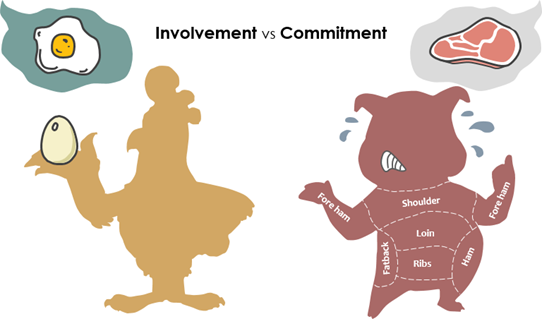Content begins here
Contenido de la página principal
Pulsa para colapsar
Involvement and commitment
Introduction
Both involvement and commitment refer to degrees of participation of an individual to a team. For many, taking part in an event, a task or even a dialogue will start with an understanding of the situation and a shared interest and objective.
Once this lesson is completed and approved, learners will be able to:
- Contextualise needs for participation and collaboration.
- Perceive the difference between several degrees of participation.
In this lesson, we will learn why we get engaged and how to engage others in projects for collaboration and teamwork.
Involvement
Involvement is the act or process of participating in something. A team member must be involved within the team and toward his mission, taking an active role, and not only passive. Indeed, participation is an active process, where people are consulted at different stages of the processes that they contribute to implement.
Running a successful project is not just about setting the right goals, choosing the right people, and giving your team members the resources to achieve those goals, it’s also about understanding the role of each person's participation versus each person’s involvement practices.
A managerial model that is related to the concept of involvement is one that grants decision-making power. This consists of the autonomy perceived by the participant to carry out their work. This trust gives confidence and value, since the participant is competent in degree to which it influences your work environment. The involvement in the project refers not only to the participant who feels good doing whatever he or she does, but who is listened to and participates in the improvement of the work and the environment.
For this, motivation must be encouraged using tools such as:
- Implementation of active listening processes.
- Assessment and utilisation of team members’ skills.
- Involvement in the decision-making process.
- Feedback loops between participants.
- Giving higher degree of autonomy and responsibility.
- Acknowledge achievements and congratulations.
- Celebration of successes.
Commitment
We talked about involvement in the previous title. Now commitment… what is the difference? In ham and eggs the chicken is involved, but the pig is committed.

In other words, commitment requires a higher degree of participation. Commitment is dedication and willingness to get involved in the business activities. Committed people honestly believe that their work is important, and they show up, follow through and stick with it. Also, this degree of participation is extremely important for leaders, as they are the ones responsible to organise the work within the team. Also, the first step to convince others to work toward a common goal is believing yourself in this goal.
Some key of commitment for are:
- Pay attention to your environment.
- Believe in your capacity to reach objectives (do not give up).
- Have tenacity and perseverance.
- Have a clear and global vision and focus.
- Be decisive, lead others on the way to success.
Commitment is the higher stage of the process of involvement, which can reach different degrees.
Here are some recommendations to increase the degree of participation and reach commitment, not only from you but also from your team:
- Show the entire iceberg, not only the surface.
Explain to your team the entire process in which they are involved. When only getting surface information and tasks to perform, people lose motivation as they don’t understand the need for those tasks. If you share the overall objectives with the team and communicate information about the need for each step of the overall process, it will reinforce their feeling of belonging to the team and willingness to contribute with high performance.
- Make decision together.
Decide in consultation with all the members of the team, as each one’s input can bring new ideas and solutions. You can also challenge your team to take the next steps (by taking care about the level of challenge given). Then, once the decision is taken, make it your own and fight for having it achieved.
- Be resilient.
Work through conflict and overcome obstacles, over time, they will reinforce your convictions and make you stronger. Also recognise your failures and learn from them to avoid them in the future.
- Celebrate.
Formal and informal celebration is important to consolidate the team. By organising celebration, you foster the relationships of team members around a positive event, creating positive common memories that will create a better atmosphere and motivation.
Conclusion
There is no team without participation of members of the teams. To take part in a project, the different team members need to feel involved in the project as a minimum, or best, be ready to commit to it. For this, they will need a shared interest and motivation that will justify their engagement. The role of a good leader will be to work on these aspects.
Video and PDF presentationPulsa para colapsar
The following video explains the content of this lesson and shows some examples:
Video T6.L2. Involvement and Commitment
Here you have the content of the video in pdf in case you need to use it in your classroom:
Lesson contents in PDFPulsa para colapsar
Here you have the contents of the lesson in PDF:

